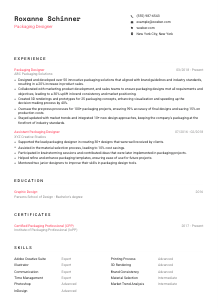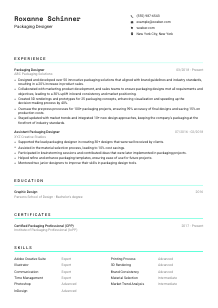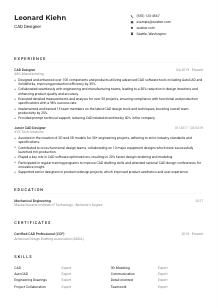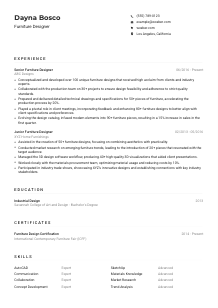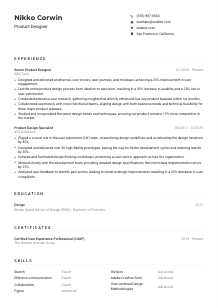Packaging Designer Resume Example
Adding aesthetics to products, but your resume's unwrapped? Delve into this Packaging Designer resume example, finessed with Wozber free resume builder. It illustrates how you can artfully showcase your design finesse to match job requirements, so your career story is as visually captivating as the packages you create!
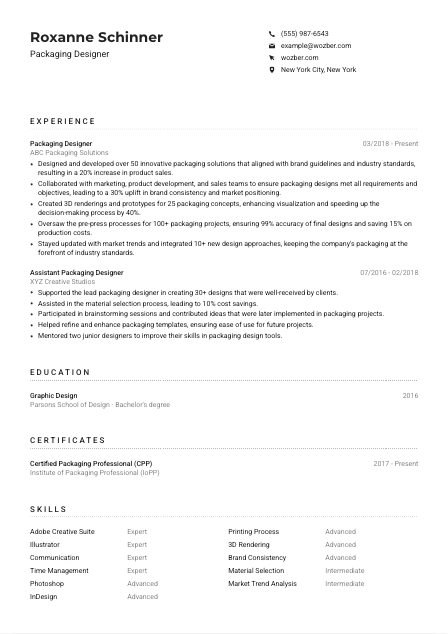
How to write a Packaging Designer resume?
Greetings, aspiring Packaging Designer! In the dynamic and visually driven field of packaging design, your resume is more than just a piece of paper – it's the canvas where you paint your professional prowess and creativity. Leveraging Wozber free resume builder, this guide will walk you through crafting a resume that not only meets the job's requisites but also passes the gatekeepers: the Applicant Tracking Systems (ATS).
Ready to transform your career prospects with an ATS-optimized, compelling resume? Let's dive deep into the realm of packaging design and set the stage for your success!
Personal Details
The Personal Details section is your first impression, the prelude to your creative symphony. Tailoring this for a Packaging Designer position means blending precision with creativity – your signature touch as a designer. Here's how to make this section resonate with the position's essence and requirements.
1. Brand Yourself with Your Name
Consider your name as your personal brand logo on the top of your resume. Ensure it's in a clean, professional font, perhaps a tad larger than the rest of the text, mimicking how you'd approach a design project – with attention to detail and branding.
2. Align Job Title
Directly below your name, align yourself with the role by listing 'Packaging Designer' as your title. This immediate association tells the hiring manager exactly what you're gunning for, akin to a product label's clarity and directness.
3. Essential Contact Info
Include your most reliable contact number and a professional email address. Think of these as the barcode on a package – simple, essential, and error-free. Remember, a typo here could mean a missed connection.
4. Match The Location
"Located in New York City, New York" – stating this shows you're already in the locus of action, ready to dive into work without logistical delays. In the design world, being where the action is matters.
5. Digital Portfolio Link
Given the visual nature of your profession, including a link to your online portfolio or personal design website can significantly bolster your application. Ensure it's current and mirrors the ingenuity in your resume.
Takeaway
Your Personal Details section is your invitation to the hiring manager, opening the door to the depths of your capabilities. Craft it with the same deliberation and intent you would a premier packaging design. First impressions count – make it professional, precise, and evocative of your design essence.





Experience
The Experience section is your portfolio in prose. It's where you narrate your design journey, spotlighting projects that resonate with the Packaging Designer role. Here's how to structure your accomplishments to mirror the job description, ensuring an ATS-compliant and meaningful narrative.
- Designed and developed over 50 innovative packaging solutions that aligned with brand guidelines and industry standards, resulting in a 20% increase in product sales.
- Collaborated with marketing, product development, and sales teams to ensure packaging designs met all requirements and objectives, leading to a 30% uplift in brand consistency and market positioning.
- Created 3D renderings and prototypes for 25 packaging concepts, enhancing visualization and speeding up the decision‑making process by 40%.
- Oversaw the pre‑press processes for 100+ packaging projects, ensuring 99% accuracy of final designs and saving 15% on production costs.
- Stayed updated with market trends and integrated 10+ new design approaches, keeping the company's packaging at the forefront of industry standards.
- Supported the lead packaging designer in creating 30+ designs that were well‑received by clients.
- Assisted in the material selection process, leading to 10% cost savings.
- Participated in brainstorming sessions and contributed ideas that were later implemented in packaging projects.
- Helped refine and enhance packaging templates, ensuring ease of use for future projects.
- Mentored two junior designers to improve their skills in packaging design tools.
1. Dissect the Job Requirements
Start with a thorough analysis of the job description. Highlight keywords such as 'innovative packaging solutions', 'cross-functional collaboration', and 'oversaw pre-press processes'. These are your cues for what the hiring manager values.
2. Chronological Format
Order your experience starting with the most recent. This not only showcases your current capabilities but also aligns with the ATS's love for clear, chronological formats. Each role should reflect your growth and expertise in the packaging design sphere.
3. Tailor Achievements
In describing each role, focus on achievements that resonate with the job description. For instance, highlight projects where you developed 'innovative packaging solutions' or worked closely with 'cross-functional teams'. This explicit alignment shows you're not just a great designer, but the right designer for the role.
4. Quantify Impact
Whenever possible, bolster your accomplishments with numbers. Did your design increase product sales by a certain percentage? Quantifiable achievements speak volumes, providing tangible proof of your design efficacy and business impact.
5. Relevance is Key
Filter your experience through the lens of relevance. Extraneous details may dilute the potency of your application. Focus on roles and projects that showcase your excellence in packaging design, speaking directly to the needs outlined in the job description.
Takeaway
Think of your experience section as the narrative of your professional journey, each role a chapter that brings you closer to your next achievement. Craft it carefully, ensuring alignment with the job description, and let your accomplishments shine. Remember, in the story of your career, you're the protagonist – make every word count.
Education
In the realm of design, education provides both foundation and credibility. It's essential to present this section as a testament to your grounding in the principles of packaging design. Let's align your educational background with the specific demands of the Packaging Designer role.
1. Highlight Required Degree
Directly align your degree with the job requirement. For instance, if you hold a 'Bachelor's degree in Graphic Design', list it prominently. This exact match reassures hiring managers of your formal training in the design domain.
2. Keep It Simple
For clarity and ATS-compliance, structure this section with straightforward elements: degree title, field of study, institution name, and graduation date. This simplicity ensures your qualifications are easy to find and understand.
3. Degree Specificity
If your degree directly matches the job requirement, it's vital to specify. For example, listing 'Bachelor's degree in Graphic Design' directly correlates with the requirement for a related field degree, making your candidacy stronger.
4. Relevant Courses and Achievements
While the degree itself is critical, spotlighting relevant courses or projects can enhance your profile. Did you excel in a particular design course or undertake a significant project related to packaging design? These details can demonstrate specialized knowledge and commitment.
5. Certifications Count
Beyond your degree, any certifications that bolster your design credentials are worth mentioning. Whether it's a Certified Packaging Professional (CPP) or software proficiency certifications, they add weight to your expertise in the field.
Takeaway
Your educational background is the scaffolding of your design acumen. Present it as a solid foundation that supports your expertise and creativity in packaging design. Remember, your education isn't just about what you've learned – it's a bridge to what you'll create.
Certificates
Certificates are like badges of honor – tangible evidence of your commitment to your craft. Especially in a field as evolving as packaging design, they demonstrate your dedication to keeping your skills sharp and up-to-date. Let's illustrate how to frame your certifications for the Packaging Designer position.
1. Recap Job Expectations
First, review the job description to identify if any specific certifications are mentioned. While the example provided does not explicitly require certifications, showcasing relevant ones can still set you apart.
2. Choose Pertinent Certificates
Prioritize certifications closely related to the demands of the role. For instance, a 'Certified Packaging Professional (CPP)' directly attests to your proficiency and specialized knowledge in packaging design.
3. Transparency with Dates
Include acquisition or validity dates for your certifications. This demonstrates not only your current qualifications but also your commitment to ongoing professional development – a desirable trait in the ever-evolving design landscape.
4. Regular Updates
The design field is dynamic, with new trends and technologies constantly emerging. Stay ahead by regularly updating your certifications. This commitment to continuous learning showcases your adaptability and eagerness to remain at the forefront of design innovation.
Takeaway
In the competitive field of packaging design, your certificates can provide a distinct advantage, underscoring your specialized skills and commitment to excellence. Highlight them strategically to enhance your resume's impact and demonstrate your dedication to professional growth.
Skills
The Skills section of your resume is akin to a design palette: it showcases the range and depth of your capabilities. In packaging design, a blend of technical proficiency and creative flair is essential. Here's how to curate a skills list that resonates with the demands of a Packaging Designer role.
1. Unpack the Job Description
Begin by dissecting the job description for both explicit and implicit skill requirements. Skills like 'proficiency in Adobe Creative Suite' and 'strong understanding of printing processes' are your keywords for matching.
2. Curate a Relevant Skill Set
Match your skills to those listed in the job description, incorporating both hard skills like 'Adobe Creative Suite' and soft skills such as 'effective communication'. This demonstrates both your technical prowess and your ability to collaborate effectively.
3. Organization and Focus
Instead of listing every skill you possess, focus on those most pertinent to the job at hand. Arrange them in a way that first highlights your design capabilities, followed by your soft skills. This organized approach makes your skills easy to navigate and assess.
Takeaway
The Skills section is more than a checklist; it's a preview of your professional arsenal. Tailored and meticulously organized, it should reflect the unique blend of creativity and technical proficiency that makes you an ideal candidate for the Packaging Designer role.
Languages
In the globally connected world of packaging design, language skills can be a significant asset. Whether it's collaborating with international teams or understanding global market trends, your linguistic abilities can open new avenues for creativity and influence.
1. Evaluate Job Requirements
First, assess the job description for language preferences. For our Packaging Designer example, 'strong English literacy skills' were a must, indicating the importance of clear and effective communication in this role.
2. Prominently Feature Essential Languages
If the job specifies a language, such as English, list it first and rate your proficiency honestly. Being fluent in the primary language of the business is crucial for understanding briefs, collaborating with teams, and ensuring your designs meet client needs.
3. Showcase Additional Languages
List any other languages you speak, as they can be a tremendous asset, especially in companies that operate on a global scale. Even basic proficiency can facilitate smoother interactions with international clients or team members.
4. Honesty in Proficiency
Be precise about your language levels. Whether you're 'Fluent' or have 'Intermediate' skills, clarity here can help manage expectations and showcase your potential for growth and cross-cultural collaborations.
5. Understand the Global Perspective
In a role that might involve international market considerations, your multi-language proficiency can be a distinctive advantage, underscoring your capability to engage with diverse markets and cultural sensibilities in your design work.
Takeaway
Language is not just a tool for communication; it's a medium for cultural exchange and understanding. In packaging design, where global trends and consumer insights matter, your linguistic skills enhance your profile, making you a versatile and valuable asset to any design team.
Summary
The Summary section is your elevator pitch – a concise narrative that encapsulates your career highlights and aligns your qualifications with the Packaging Designer position. It's where you weave your professional identity, crafting a narrative that's compelling and reflective of your design philosophy.
1. Capture the Job's Essence
Digest the job description to understand the core expectations. This insight will help you frame a summary that speaks directly to what the role demands, presenting you as the solution to their needs.
2. Lead with Your Identity
Begin with a strong, identity-affirming statement. For example, 'Experienced Packaging Designer with a penchant for innovative solutions…' sets the tone for your professional narrative, asserting your role and expertise right off the bat.
3. Echo the Critical Requirements
Weave in aspects of your experience and skill set that directly respond to the job description. Mentioning your proficiency in Adobe Creative Suite, for example, addresses a specific requirement, reinforcing your suitability for the role.
4. Conciseness is Key
Your summary should be succinct yet powerful. In a few sentences, encapsulate your experience, key achievements, and the unique value you bring to the Packaging Designer position. Think of it as your design statement – impactful and memorable.
Takeaway
A well-crafted summary not only introduces you to the hiring manager but also sets the stage for your resume. It's your opportunity to make an indelible first impression, showcasing your expertise and passion for packaging design. Let it reflect your professional journey with clarity and conviction.
Designing Your Career Path as a Packaging Designer
Congratulations! You've now navigated the intricate process of tailoring your resume for a Packaging Designer position. Remember, your resume is a reflection of your professional journey, imbued with your creativity and vision. Use Wozber's free resume builder, equipped with ATS-friendly resume templates and an ATS resume scanner, to ensure your application stands out.
Your talent and preparation have set the stage – now, let your resume open doors to exciting opportunities in the world of packaging design. Ready to embark on your next creative adventure? Let's make your design aspirations a reality!

- Bachelor's degree in Graphic Design, Packaging Design, or a related field.
- Minimum of 3 years experience in packaging design or a related field.
- Proficiency in Adobe Creative Suite, specifically Illustrator, Photoshop, and InDesign.
- Strong understanding of printing processes and materials.
- Effective communication, collaboration, and time management skills.
- Must have strong English literacy skills.
- Must be located in New York City, New York.
- Design and develop innovative packaging solutions that align with brand guidelines and industry standards.
- Collaborate with cross-functional teams, including marketing, product development, and sales, to ensure packaging meets all requirements and objectives.
- Create 3D renderings and prototypes to visualize packaging concepts.
- Oversee pre-press processes to guarantee the accuracy of final packaging designs.
- Stay updated with market trends, consumer insights, and competitive packaging designs to ensure a fresh and relevant approach.





